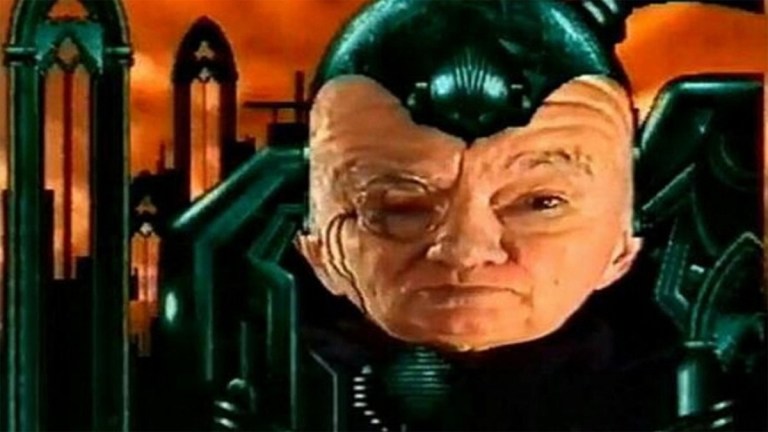GamesMaster: Before YouTube and Twitch, Sir Patrick Moore’s Floating Cyborg Head Was the Best in Gaming TV
In its 30th anniversary year, the excellent 1990s UK show presented by Dominik Diamond remains the high water mark of videogame television

GamesMaster was that rare breed of show that was somehow both a commercial smash hit and a cult phenomenon. For seven series, it was essential viewing for games enthusiasts and lovers of snark everywhere. All of its elements – the masterstroke casting of sardonic Scotsman Dominik Diamond as host; the sight of beloved astronomer Sir Patrick Moore’s disembodied cyborg head as the eponymous GamesMaster; the humour, the authority, the scoops, the fun, the anarchy – combined to create a show that for many was synonymous with and indivisible from the gaming industry it fed upon and reflected.
In the years since it went off air, its name has been whispered in reverent tones across online forums, and at parties where people of a certain vintage gather to trade nostalgic remembrances. Will it ever come back? Should it ever come back? Well, in 2021 GamesMaster did come back, rebooted on E4 with a whole new cast and production crew.
There is some brand continuity with the original, namely in the casting of another sardonic Scotsman as the lead presenter, and the co-opting of another UK National Treasure to don the GamesMaster garb, this time former newscaster Sir Trevor MacDonald. The three episodes that have aired to date have been slick, confident, even funny, and while it may be too early to tell if it can cement a similar place for itself in the annals of TV legend, it seems unlikely that this show, or any other like-minded show, will ever match the heights, mass-appeal and influence of 1990s GamesMaster.
Here’s how the original show, and the teams and talent responsible for its inception and production managed to catch lightning in a bottle, and hold it there for three decades and counting.
The First Challenges
In the days before the internet, the only exposure gamers had to information about the latest games and gaming technology was through magazines. They could read reviews, hints and tips, see screenshots of upcoming titles, but it was nothing compared to the visceral thrill of seeing game footage unfolding before their very eyes on their TV screens. Beyond the odd brief, stuttered segments on Saturday morning kids’ shows, there had never been anything like GamesMaster, and nothing that followed in its wake would ever surf the zeitgeist with anything like the same poise, confidence or level of mastery. Nor garner the same astronomical viewing figures.
Central to the show’s appeal were its challenges, where kids could compete against each other, or sometimes celebrities, in computer-based gladiatorial combat to win the coveted GamesMaster Golden Joystick. Friend vs friend; brother vs brother; some random dude vs Barry McGuigan… Watching these exchanges through contemporary eyes via the magic of YouTube, it’s amazing how engaging it still feels, despite the fact that some of the games are positively antediluvian by today’s standards. But then…
“GamesMaster wasn’t really a show about video games,” Dominik Diamond told The Guardian in 2021. “It was about a bunch of mates having a laugh while playing video games, and that’s why it succeeded.”
That’s also precisely how it started. In 1990, Jane Hewland – the sort of devil-may-care doyenne who sets up a production company during a recession – bought her 10-year-old son Harry a Nintendo for Christmas. Watching Harry play Duck Hunt gave Jane the bare bones of the idea for GamesMaster. Few commissioning editors seemed interested. Undeterred, she filmed Harry and his friends talking about what video games meant to them, and used the footage to convince Channel 4 that there was mileage, merit and money in the format. They agreed. Looking at the societal and industry landscape around them at the time it seems mildly insane that anyone ever hesitated.
Timing is Everything
The early 90s saw an explosion in home computing that made video games a global force to be reckoned with. Graphics and processing power moved away from the plinky, plonky, bitty, blocky, bluntness of the cassette-tape-powered ZX Spectrum towards the cutting-edge and pop-culture-invading appeal of Sega and Nintendo. Mushroom-gobbling plumbers and ring-obsessed hedgehogs became household names. Kids no longer wanted to do boring things like play outside, talk to each other, read, or even go to their local arcade: all they wanted to do was sit in their bedrooms waggling their joysticks. More on that later.
If the war generation and the boomers that followed them thought that The Beatles or punk had driven a wedge through the family, then at least they could take comfort from the fact that their children’s passions had recognisable roots in music, regardless of how mutated they considered the strain. Video games, on the other hand, had no real equivalent basis in the experiences of the pre-computer generation – unless you want to argue that Hangman was a precursor to Pac-Man, and good luck to you if you do. Not only did the gaming world have its own music, but its own hardware, its own language. It was a sub-culture that was hard to penetrate unless you too had a joystick in hand, and the free-and-easy leisure hours with which to master its use. Which, of course, most older people didn’t. There was a wide-open gap in the market.
GamesMaster, then, came along at just the right time to mine these emergent, interlocking seams of youth culture, glitz, and entertainment, and it wrapped the resulting raw goods in a package that was ground-breaking, good-looking, youthful, edgy, enjoyable, informative, funny, and, frankly, cool.
Rough Diamond
The show’s look and feel was a strong factor in its success. Each series took place in a new location (in chronological order: a church, an oil rig, a ‘prison’, hell, heaven, Atlantis and a desert island) and the sets were always immaculately dressed, lit and realised. But, arguably, it was one on-air element, above all others, that was instrumental in the show’s popularity: Dominik Diamond.
We already know that young Harry Hewland was the catalyst for GamesMaster‘s existence, if only by virtue of his own existence. But what many people don’t know is that he was also responsible for the decision to hire Diamond as the show’s host. In a manner of speaking.
Diamond had reached the final 12 candidates to be a presenter on Channel 4’s new flagship late-night magazine show The Word, but didn’t make the final cut. Fortuitously for him – and for us – GamesMaster‘s production team reached out to their equivalents in The Word to ask if they’d auditioned anyone who might be suitable for their new show, and Diamond’s name was put forward. The tape for his GamesMaster audition, in which he commentated on a gaming challenge, peppering his performance with double-entendres about ‘waggling joysticks’, made the production team – and, crucially, Jane Hewland’s son, Harry – laugh so hard that the deal was sealed.
“It was the irreverent sense of humour that gave GamesMaster credibility with its audience: adolescent boys,” Hewland told The Guardian in 2021. “For the kids to like us, we had to be badly thought of by authority figures. Also, we had to be slightly weird, like a secret world they could join in.” It’s hard to read that last sentence without picturing Dominik’s eyes casting a mischievous glint through the round lenses of his trademark specs.
I’m Going Through Changes…
For the first two series of the show Dominik Diamond had the floppy-haired, red-jacketed feel of a Butlins Redcoat revelling in the act of smuggling smut and cynicism over the heads of would-be censors – at half-past six in the evening, no less. Audiences loved him, but Diamond – though he loved the show – wasn’t quite so enamoured with his look. Especially the jacket. When McDonalds became the show’s official sponsor ahead of series three, a combination of ideological objection and dissatisfaction with his own lack of creative control prompted him to hang up the red jacket, seemingly for good. He even filmed a ‘death’ scene for the end of series two.
Actor and now director Dexter Fletcher was parachuted in as the presenter for the next series. Some felt that his brand of wide-eyed, bouncy enthusiasm was an ill-fit for the format, which was arguably reflected in dwindling viewing figures. Negotiations ensued, and Diamond was brought back into the fold for series four, this time with a new production team, and much more control over his appearance and direction.
Series four opened with a short-cropped, still bespectacled Dominik Diamond – dressed very much like an SS Officer who occasionally moonlighted as the Milk Tray Man – addressing the audience with the prophetic words: “I’m Dominik Diamond. I’m back. And I’m grumpy.”
The path was paved for Diamond’s winning style of open mockery, withering disdain, outrageous filth, and sensational stunts. Over the next four series, he cracked jokes about having crabs, insinuated that Sir Patrick Moore would struggle to take a parsnip inside of him, insulted the haircuts of the child contestants, attempted to get babies to play computer game challenges, and even ‘married’ Euro pop-star Whigfield against her will. Not forgetting his famous on-air friction with presenter and self-styled games guru Dave Perry, who quit the show during the series six Christmas special, claiming that he’d been set up over a failed Super Mario challenge.
But all of the hijinks, all of the edgy humour, all of the later trips to Japan and Hollywood, wouldn’t have meant a thing if there hadn’t been a bond of trust between GamesMaster and its audience. Diamond and the team were gamers, too, and understood both the world in which they operated, and the audiences that flocked to their show. “We didn’t take ourselves or the games industry too seriously,” Dominik told Alain Boiston in this excellent and in-depth Team VVV interview. And, crucially: “We weren’t afraid to say something was pants if it was pants.”
They worked with the big players in the industry, but were never in thrall to them, nor would they bow to their corporate masters at Channel 4. Their fealty was always to the audience. To the gamers themselves. And – even if the ascendancy of gaming on YouTube and Twitch hadn’t made the whole concept of TV shows about computer games almost a moot point now – that might be the hardest element of all to recapture.
